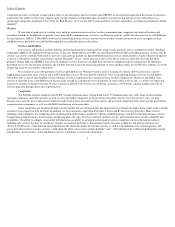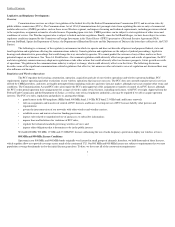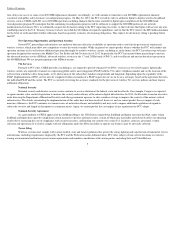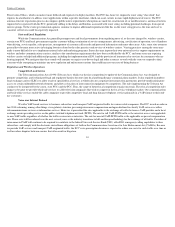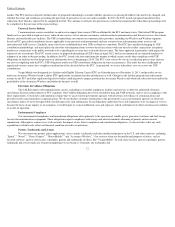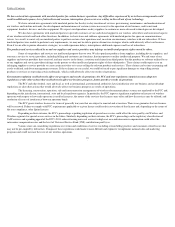Sprint - Nextel 2013 Annual Report Download - page 17
Download and view the complete annual report
Please find page 17 of the 2013 Sprint - Nextel annual report below. You can navigate through the pages in the report by either clicking on the pages listed below, or by using the keyword search tool below to find specific information within the annual report.
Table of Contents
services or that consumers prefer over ours. If we are unable to meet future advances in competing technologies on a timely basis, or at an acceptable cost, we
may not be able to compete effectively and could lose subscribers to our competitors.
Some competitors and new entrants may be able to offer subscribers network features or products and services not offered by us, coverage in areas
not served by our wireless networks or pricing plans that are lower than those offered by us, all of which would negatively affect our average revenue per
subscriber, subscriber churn, ability to attract new subscribers, and profitability.
The success of our network modernization plans, will depend on the timing, extent and cost of implementation; access to spectrum; the performance of
third
-
parties and related parties; upgrade requirements; and the availability and reliability of the various technologies required to provide such
modernization.
We must continually invest in our wireless network in order to continually improve our wireless service to meet the increasing demand for usage of
our data and other non
-
voice services and remain competitive.
Improvements in our service depend on many factors, including our ability to adapt to future changes in technologies and continued access to and
deployment of adequate spectrum, including any leased spectrum. We must maintain and expand our network capacity and coverage as well as the associated
wireline network needed to transport voice and data between cell sites. If we are unable to obtain access to additional spectrum to increase capacity or to deploy
the services subscribers desire on a timely basis or at acceptable costs while maintaining network quality levels, our ability to retain and attract subscribers
could be adversely affected, which would negatively impact our operating margins.
If we fail to provide a competitive network, our ability to provide wireless services to our subscribers, to retain and attract subscribers and to
maintain and grow our subscriber revenues could be adversely affected.
Using a new and sophisticated technology on a very large scale entails risks. For example, deployment of new technology from time to time has, and
in the future may, adversely affect the performance of existing services on our networks and result in increased churn. Should implementation of our upgraded
network be delayed or costs exceed expected amounts, our margins could be adversely affected and such effects could be material. Should the delivery of
services expected to be deployed on our upgraded network be delayed due to technological constraints, performance of third
-
party suppliers, zoning and
leasing restrictions or permit issues or other reasons, the cost of providing such services could become higher than expected, ultimately increasing our cost to
subscribers and resulting in decisions to purchase services from our competitors, which would adversely affect our revenues, profitability and cash flow from
operations.
Current economic and market conditions, our recent financial performance, our high debt levels, and our debt ratings could negatively impact our access
to the capital markets resulting in less growth than planned or failure to satisfy financial covenants under our existing debt agreements.
We expect to incur additional debt in the future for a variety of reasons, such as refinancing our maturing debt, financing our network modernization
plan or other working capital needs, including equipment net subsidies, future investments or acquisitions. Our ability to obtain additional financing will depend
on, among other factors, current economic and market conditions, our financial performance, our high debt levels, and our debt ratings. Some of these factors
are beyond our control, and we may not be able to obtain additional financing on terms acceptable to us or at all. Failure to obtain suitable financing when
needed could, among other things, result in our inability to continue to expand our businesses and meet competitive challenges, including implementation of our
network modernization plan on our current timeline.
Instability in the global financial markets may result in periodic volatility in the credit, equity and fixed income markets. This volatility could limit our
access to the credit markets, leading to higher borrowing costs or, in some cases, the inability to obtain financing on terms that are acceptable to us or at all.
We have incurred substantial amounts of indebtedness to finance operations and other general corporate purposes. Our consolidated principal
amount of indebtedness was $31.5 billion at December 31, 2013. As a result, we are highly leveraged and will continue to be highly leveraged. Accordingly, our
debt service requirements are significant in relation to our revenues and cash flow. This leverage exposes us to risk in the event of downturns in our businesses
(whether through competitive pressures or otherwise), in our industry or in the economy generally,
15



